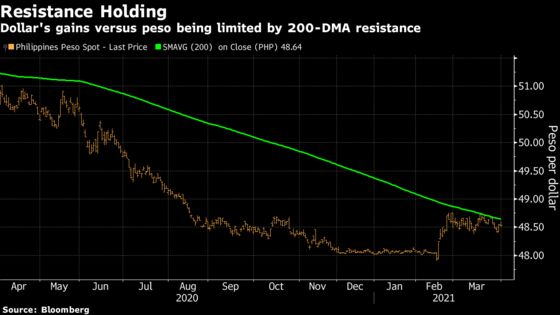Peso May Seal Lead Over Baht as Philippine Trade Deficit Shrinks
Peso May Seal Lead Over Baht as Philippine Trade Deficit Shrinks
(Bloomberg) -- The Philippine peso and the Thai baht offer a tale of contrasting fortunes, with one faring better than the other against a strong dollar.
The peso dropped 1% against the greenback in the first quarter, outperforming the baht whose 4.2% decline made it emerging Asia’s laggard. The divergence is likely to persist in the coming three months as the Philippines’ trade deficit narrows while Thailand’s tourism industry languishes.
As a rising dollar reasserts itself, local factors are helping to determine which regional currencies can better withstand the fallout. Still, a weaker exchange rate may not be an undesirable outcome for Asian policy makers, with the likes of the Bank of Thailand consistently arguing against a strong currency to protect exporters.
“The Philippine peso has been driven by expectations on its trade balance,” said Eugenia Fabon Victorino, head of Asia strategy at SEB in Singapore. “The baht is dealing with persistently weak portfolio flows which is exacerbated by the propensity of local corporates to raise outbound investments considering the weak domestic demand in Thailand.”

The peso rallied to 47.90 to the dollar in mid-February, the strongest since September 2016. It’s being supported by a steady stream of overseas remittances and expectations for the Philippines’ trade shortfall to shrink as virus-related curbs damp domestic demand and imports.
A report due Thursday may confirm this, with economists in a Bloomberg survey forecasting that the deficit narrowed to $2.25 billion in February from $2.42 billion the previous month.
All these positives have helped offset the impact of falling real interest rates after Bangko Sentral ng Pilipinas kept policy on hold even as inflation quickened. Technicals also favor the Philippine currency, with the dollar-peso currency pair facing resistance at its 200-day moving average, currently around 48.64.

In contrast, the outlook for the baht appears less rosy. After bearishly breaching support at around 31.00 to the dollar, the path is clear for Thailand’s currency to fall toward its July low of 31.858.
Beyond technicals, the baht lost a pillar of support after Thailand’s long-standing current-account surplus turned into a deficit as tourism collapsed in the face of the pandemic. Equity outflows totaling almost $1 billion in the first quarter may have also hurt the currency.
Additionally, the central bank has pledged to keep policy accommodative after lowering its 2021 growth forecast to 3% from 3.2% at a meeting last month.
With the baht’s headwinds unlikely to subside anytime soon, it appears more likely than not that the currency will continue to trail its Philippine peer.
Below are the key Asian economic data and events due this week:
- Monday, April 5: Singapore retail sales, Japan services PMI, Thailand CPI
- Tuesday, April 6: RBA policy decision, Japan labor cash earnings, China Caixin services PMI, Philippine CPI
- Wednesday, April 7: South Korea BoP current account balance, RBI policy decision
- Thursday, April 8: New Zealand business confidence, Japan BoP trade and current account balance, Philippine trade balance, Thailand consumer confidence
- Friday, April 9: RBA Financial Stability Review, China CPI and PPI, Malaysia industrial production
©2021 Bloomberg L.P.